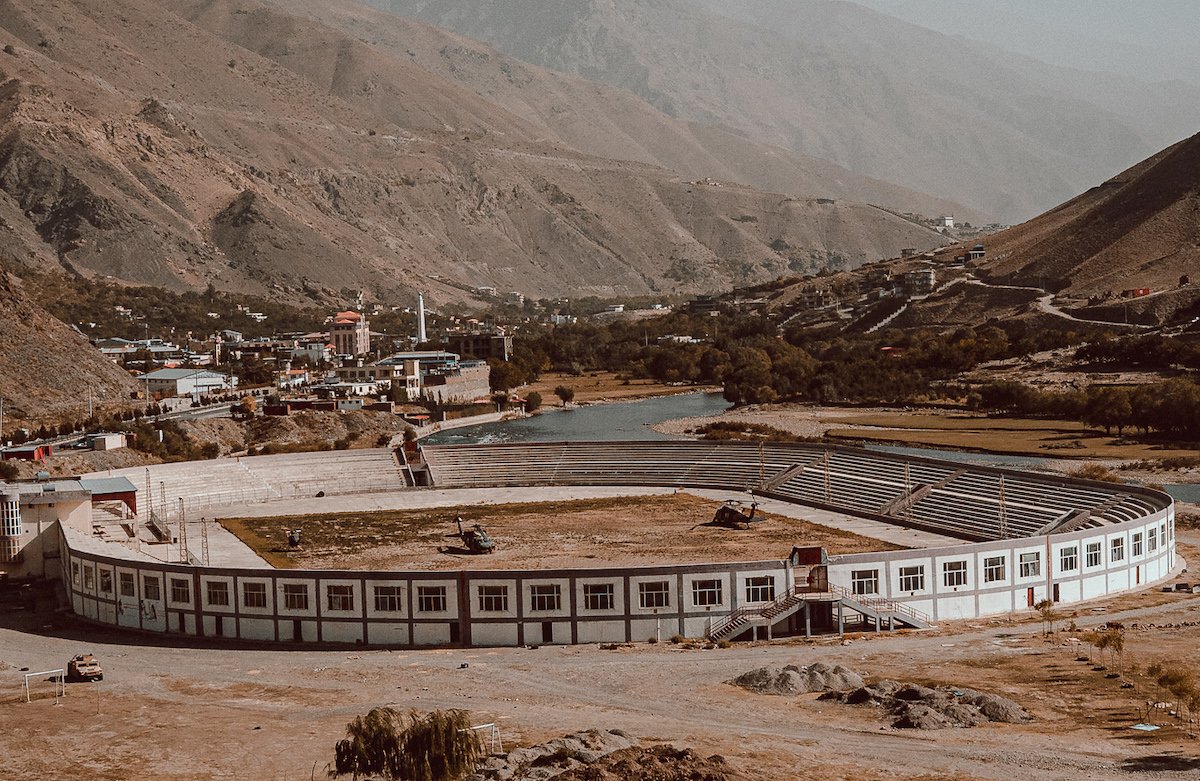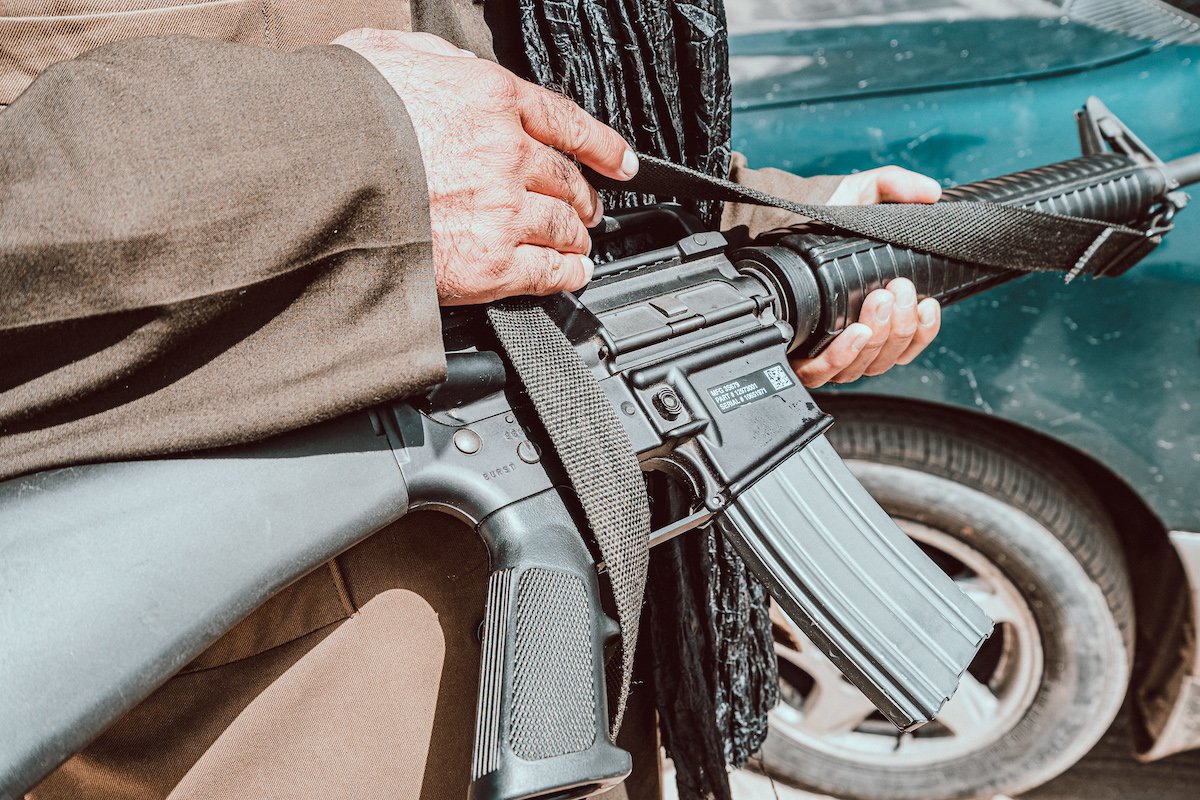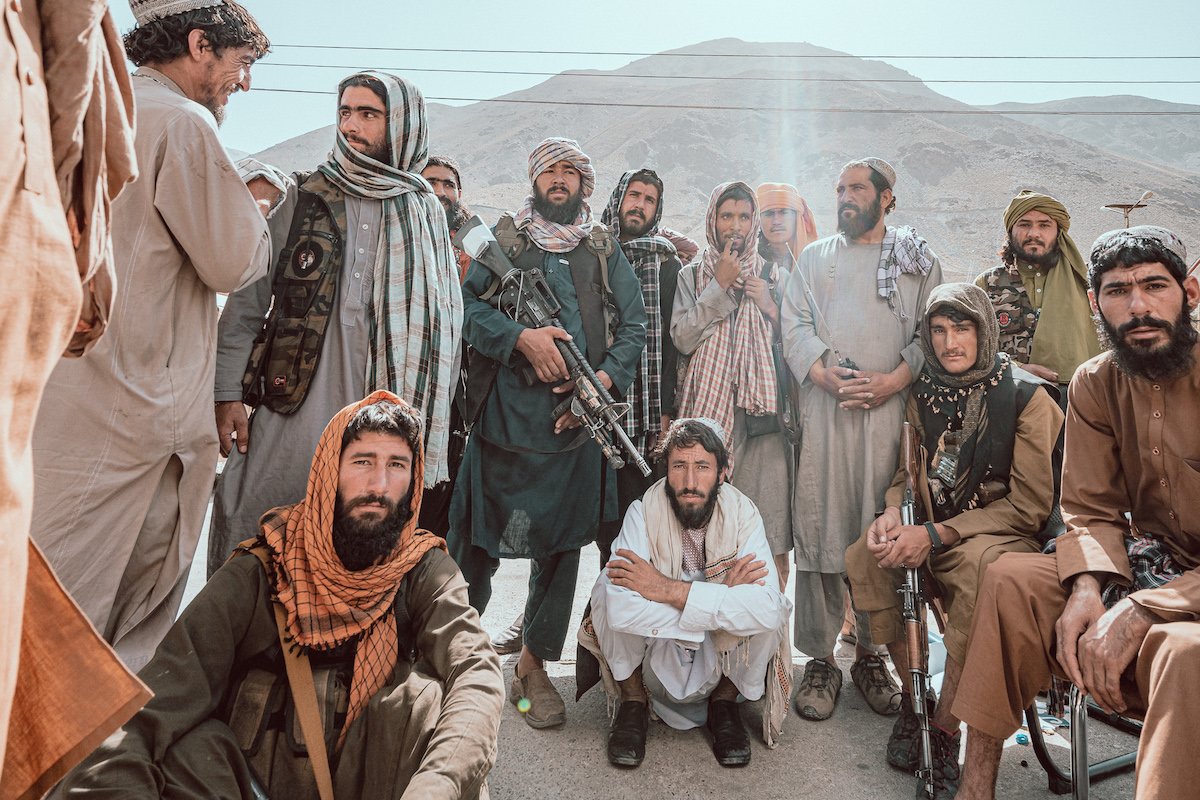DISPATCH: With an Arsenal of US-Made Weapons, the Taliban Storm Through Panjshir

An old Soviet tank placed in the middle of the road at the entrance of the Panjshir Valley. Photo by Jacob Simkin.
PANJSHIR, Afghanistan — This valley has long been a place of military mythology. Panjshir was the pivot point, the legend goes, that repelled the Soviet invaders in the 1980s and the only province not to fall to the Taliban in the 1990s. It was the lone, majestic parcel of peace throughout the US-led war of the 2000s.
And it was hoped that it would be a final frontier of anti-Taliban resistance following the dizzying Taliban takeover in 2021.
But from where I sit, traveling through all eight districts of the prized Panjshir Valley, the Taliban dominance through the main thoroughfares is absolute. Some 8,000 fighters belonging to the former insurgency oversee the main roads and infrastructure. White-and-black flags flutter high on billboards and government buildings, mosques, and abandoned market squares.

While the local National Resistance Front is said to still be battling it out in caves and crevices in and around the distant mountains, it is evident that they face a chilling fight against American-made weapons inherited from the defunct Afghan National Army. The Taliban roll through the winding tracks, primarily wielding American M4-style rifles and the occasional SAW and PKM. Several .50-caliber machine guns are also hoisted on the back of trucks. Some Taliban possess armored vehicles, and others have small, battered cars still emblazoned with stickers of the famed leader who last threw them back: Ahmad Shah Massoud, the “Lion of Panjshir” whom al Qaeda assassinated in 2001, two days before the 9/11 attacks.
Taliban leaders repeatedly make their point clear: Surrender, or we use force.
“Panjshiris are our brothers; we don’t want to fight them,” said Haji Asad, the Kandahar-based Taliban commander who has taken an office adjacent from Massoud’s tomb. “We have announced general amnesty. [They] should not live with fear in their hearts. Come down from the mountains and live in your homes.
“Either surrender today, or we will be capturing them.”

“We initially give them a time to surrender. Then, if they don’t surrender, we shoot,” cautioned Mawlawy Khalid, a Taliban commander based inside the Panjshir Revenue Department who leads a reserve force from Farah province, 500 miles away.
Khalid explained that the difference between Panjshir and other places was that many forces had assembled inside the province as the country started to fall, and they had “tried to stand up.” Those who surrender and hand in their weapons are issued a letter rendering them “free” to return home and go about their daily lives, Khalid said.
About 100 to 200 people are surrendering each day, Asad said. Seated in a long line inside his newly taken office are community elders who deploy to the mountain hideouts to guide fighters and civilians alike down for formal surrenders.
“Afghanistan fought the biggest military in the world, and we took [back] our freedom,” claimed one elder, who hailed from Logar province.
But with no cell coverage in the mountains, for Panjshir activists on the outside who cannot reach their loved ones on the inside, their distrust is unmistakable, and they fear the worst. Meanwhile, the Taliban themselves use UAE-based Etisalat for their cell service, which seems to work in some central areas.
Despite weeks of ambiguity and the shuttering of communication lines inside the enclave as the Taliban forces encircled it, there is no destruction evident through the main artery. The most visceral testimony to the fighting in Panjshir exists in the handful of languishing US-made vehicles: HMMWVs, Ford Rangers, and one hulking, MRAP-like mineproof armored vehicle.
However, Panjshir is still one of the rawest, most beautiful places on earth, with its gushing jade streams and rolling mountains that shielded the population from the bloodletting happening throughout the rest of Afghanistan for more than 20 years. Now, the conflict is more a haunting fear of the unknown, the bloodletting out of sight.
Mawlawi Sher Ali, a 40-year-old imam who casually said that he spent seven years behind bars in Kabul for “fighting foreigners,” also now meanders through the somber streets.
“People should come down,” he insisted. “Things have been getting back to normal.”
Yet things appear far from ordinary on the ground. Everything is closed, and only a few local figures float through, their faces filled with angst and inquisitiveness as the Taliban trundle by. Families continue to flee, the contents of their lives strapped atop vans stuffed with Panjshiris of all ages.
In the mountains, the skirmishes continue.
Panjshir’s rugged topography, laced with cavities and valleys, has long given the Panjshiri resistance — now officially termed the National Resistance Front — the upper hand in its combat with outside forces. The NRF is said to not only be made up of battle-hardened Panjshiris but also Afghan security forces and militias. Thus, it is possible that the most determined parts of the NRF, while seeming to have lost control of central areas and infrastructure, are still amassing atop the mountains and inside the terrain that the Panjshiris know best.
Thus, while the United States’ “forever war” might be over, some Panjshiris remain defiant, carrying on a fight that truly is eternal.

“It has gone back to the Soviet times, with fighters all through the mountains,” one former Panjshiri commander tells me defiantly. “We will never surrender. We will fight to our [last] breath.”
High-ranking Talib fighter Hussein Ahmad — who said he was 33 or 34 — said simply that he “grew up among many Taliban” and completed his Islamic studies before enrolling with the Taliban. While fighters don’t receive formal training, they have developed solid military strategies from their years in the war theater.
“On the way into Panjshir, there is a bridge that the resistance destroyed. We spent one and a half day to make a way between the water to enter,” he explained, glancing out at the undulating terrain. “It took us seven days to capture the full area.”
The Taliban fought from the valleys and ground while the resistance battled back from the top, Asad said.
“What the Taliban did was not only come from two ways; we came from all four ways,” he went on.

Takhar and Baghlan border the enshrined province to the north, Badakhshan and Nuristan to the east, Parwan to the west, and Laghman and Kapisa to the south.
Qari Ramazan, 20, said he, too, had completed religious studies around three years ago, and thus, it was “easy to get in” to the Taliban from there. And Nayeem, 22, said he joined around six years ago. Nonetheless, he claimed not to know anything about Usama Bin Laden or the attacks of Sept. 11, 2001, or why America even came to Afghanistan in the first place.
And Asad, who said he had begun his religious studies at 14 and then joined the Taliban at 18 — and had subsequently been on the battlefield for 14 years — vowed he was committed to the cause.
“The US could not achieve their goal of occupation,” he continued. “We expect other countries to not interfere. We want good relations with all of them, including the United States.”
But the Taliban does not shy away from expressing that they now have even bigger military objectives that go beyond quelling any remnants of rebellion inside Panjshir.
“All the [Afghan security forces who want to return] will come back to operations, and we will re-activate the Air Forces and all the other forces,” Asad said, highlighting that they had the personnel and capabilities to do so. “We have the team for all the helicopters and everything in place, even before capturing Kabul. So we are fully operational.”
On top of their newly commandeered American hardware, it is not lost on the Taliban that they are also now sitting on the extraordinary, untapped wealth of Panjshir’s massive array of minerals and gems ripe for mining.
“Half the wealth [of Afghanistan] is in Panjshir,” Asad added. “And now, we have it.”
Read Next:

Hollie McKay is a foreign correspondent, war crimes investigator, and best-selling author. She was an investigative and international affairs/war journalist for Fox News Digital for over 14 years where she focused on warfare, terrorism, and crimes against humanity; in 2021 she founded international geopolitical risk and social responsibility firm McKay Global. Her columns have been featured in publications including the Wall Street Journal and The Spectator Magazine. Her latest book, Only Cry for the Living: Memos From Inside the ISIS Battlefield, is now available.
BRCC and Bad Moon Print Press team up for an exclusive, limited-edition T-shirt design!
BRCC partners with Team Room Design for an exclusive T-shirt release!
Thirty Seconds Out has partnered with BRCC for an exclusive shirt design invoking the God of Winter.
Lucas O'Hara of Grizzly Forge has teamed up with BRCC for a badass, exclusive Shirt Club T-shirt design featuring his most popular knife and tiomahawk.
Coffee or Die sits down with one of the graphic designers behind Black Rifle Coffee's signature look and vibe.
Biden will award the Medal of Honor to a Vietnam War Army helicopter pilot who risked his life to save a reconnaissance team from almost certain death.
Ever wonder how much Jack Mandaville would f*ck sh*t up if he went back in time? The American Revolution didn't even see him coming.
A nearly 200-year-old West Point time capsule that at first appeared to yield little more than dust contains hidden treasure, the US Military Academy said.












